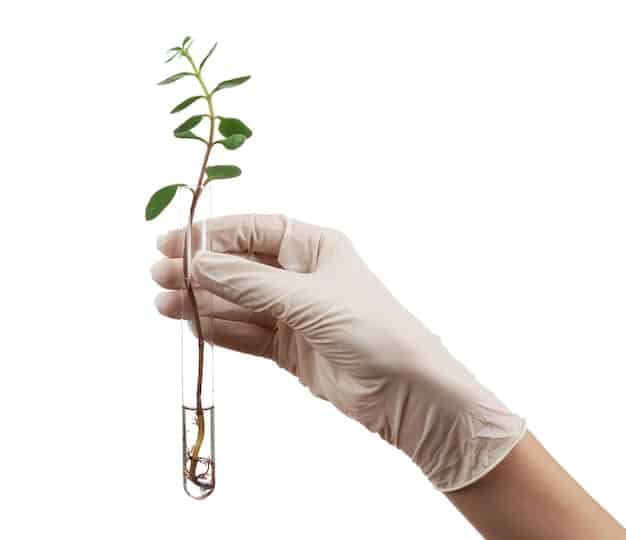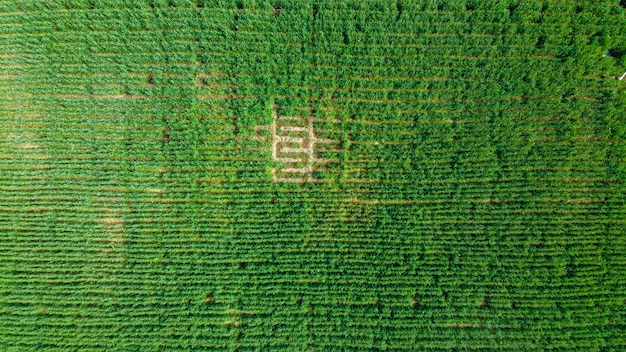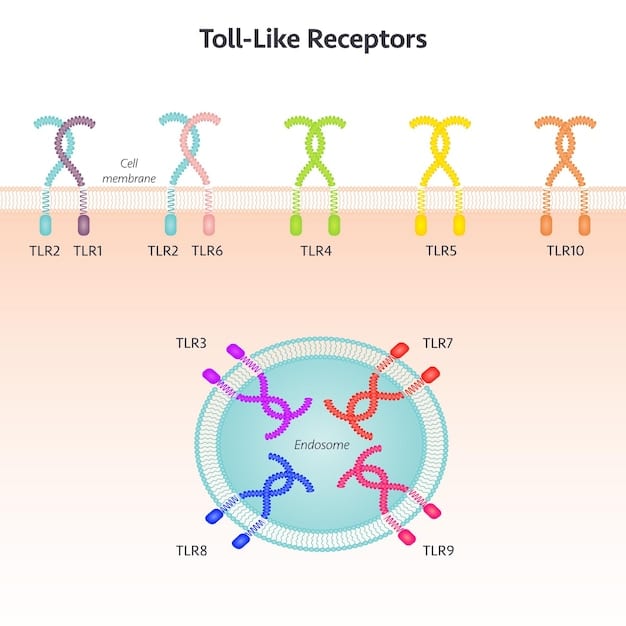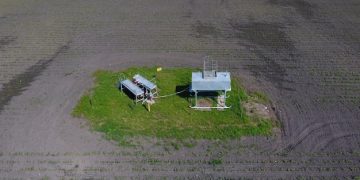Gene Editing for Crop Resilience: USDA Regulations & Benefits

Gene editing technologies hold immense potential for enhancing crop resilience, but their application is closely monitored by the USDA to ensure safety and environmental sustainability, balancing innovation with responsible agricultural practices.
Gene editing is revolutionizing agriculture, offering pathways to develop crops better equipped to withstand environmental stresses. Understanding the landscape from the USDA regulations to potential benefits is crucial for shaping the future of food production in the US.
The Promise of Gene Editing for Agriculture
Gene editing is not just a buzzword; it’s a cutting-edge approach to crop improvement. With increasingly unpredictable climate patterns and pest pressures, the ability to precisely alter plant genes offers a powerful toolkit for developing more resilient and productive crops. This section explores the basic concepts and potential impacts of gene editing.
This technology allows us to target specific genes responsibly, enhancing desirable traits like drought tolerance, pest resistance, and improved nutritional content. Considerably impactful, especially with the challenges current climate events present to farmers and the global food supply.
What is Gene Editing?
Gene editing involves making precise changes to an organism’s DNA. Unlike traditional genetic modification, which often introduces foreign genes, gene editing can precisely modify existing genes or even insert new ones in a highly targeted manner.
Benefits of Gene Editing in Crop Development
Enhanced resilience to environmental stresses, reduced pesticide use, and improved nutritional profiles are just a few potential benefits. The main focus is to create crops that can thrive in challenging conditions, securing food supplies for future generations.

Here are the specific benefits of gene editing in the field:
- Drought Tolerance: Creating crops that require less water, crucial in arid and semi-arid regions.
- Pest Resistance: Reducing the need for pesticides by enhancing plants’ natural defenses.
- Improved Nutrition: Increasing the levels of essential vitamins and minerals in staple crops.
In summary, gene editing displays a potential to revolutionize crop production. By using this cutting-edge technology, it is possible to create food crops that are healthier, more resistant and better suited to the current earth.
Understanding USDA Regulations
The USDA plays a central role in regulating gene-edited crops. Given the importance of safety and environmental protection, understanding these regulations is paramount for both developers and consumers. To better understand the guidelines, we will delve into the specifics of the regulatory framework.
The USDA’s approach is risk-based, focusing on products that pose a potential plant pest risk. This section examines the criteria used to determine whether a gene-edited crop falls under USDA oversight. It’s crucial to understand how these regulations are structured to navigate the path to commercialization.
The SECURE Rule
The SECURE (Sustainable, Ecological, Consistent, Uniform, Responsible, Efficient) rule outlines the USDA’s current approach to regulating genetically engineered organisms. This rule focuses on assessing the risk of plant pests.
Navigating the Regulatory Path
Developers of gene-edited crops need to understand the data required for regulatory review and the steps involved in obtaining approval. This includes demonstrating that the crop does not pose a plant pest risk.
Here are some considerations to take in preparation when navigating the regulatory path:
- Data Collection: Gather comprehensive data on the crop’s characteristics and potential environmental impacts.
- Consultation with USDA: Engage in early discussions with the USDA to understand regulatory expectations.
- Transparency: Maintain open communication with stakeholders to build trust and address concerns.
In conclusion, it’s imperative that those in the field of research and development understand the landscape that has been created by the USDA. It is the key to developing crops that can be approved and brought to market.
Gene Editing Techniques: CRISPR and Beyond
CRISPR-Cas9 has become a household name in gene editing, but there are other techniques as well. CRISPR isn’t the only tool in the toolbox, and understanding alternative approaches can broaden the possibilities for crop improvement. This section explores the mechanisms and applications of various gene editing technologies.
In addition to CRISPR, techniques like TALENs and zinc finger nucleases offer alternative strategies for making precise changes to plant genomes. Additionally, other methods also offer unique advantages and applications. It’s crucial to comprehend how these methods work to identify opportunities for crop improvement and enhancement.
CRISPR-Cas9: A Revolutionary Tool
CRISPR-Cas9 is a powerful and versatile gene editing system that allows scientists to make precise changes to DNA with unprecedented ease. This has opened new avenues for crop improvement.
Alternative Gene Editing Technologies
TALENs and zinc finger nucleases are other gene editing technologies that offer alternative approaches to modifying plant genomes. Each technology has its own strengths and limitations.

Gene editing technologies and applications:
- Precision: CRISPR-Cas9 allows for highly targeted modifications, minimizing off-target effects.
- Efficiency: TALENs and zinc finger nucleases can be effective in certain plant species where CRISPR-Cas9 may be less efficient.
- Versatility: Different gene editing techniques offer flexibility in terms of target sequence and modification type.
In summary, there are many new and emerging technologies that can be used to edit organisms to make them better for human use. CRISPR-Cas9 is a versatile tool that is revolutionizing the process.
Addressing Public Perception and Ethical Considerations
Public acceptance is crucial for the successful adoption of gene-edited crops. Concerns about food safety, environmental impacts, and ethical implications need to be addressed through open communication and transparency. Understanding both the pros and cons is essential for developing a trust between consumers and developers.
Building trust requires addressing concerns about unintended consequences and ensuring that gene-edited crops are developed responsibly. Transparency is key to fostering acceptance and promoting informed decision-making. This section delves into strategies for engaging the public and addressing ethical dilemmas.
Transparency and Labeling
Clear and transparent labeling of gene-edited foods can help consumers make informed choices. This includes providing information about the benefits and potential risks associated with these products.
Engaging Stakeholders
Farmers, consumers, scientists, and policymakers need to be involved in discussions about the development and regulation of gene-edited crops. Collaborative dialogue can help address concerns and build consensus.
Strategies for building trust:
- Open Communication: Providing clear and accessible information about gene editing technologies and their applications.
- Stakeholder Engagement: Involving diverse groups in discussions about the ethical, social, and environmental implications of gene editing.
- Independent Research: Supporting independent studies to assess the safety and environmental impacts of gene-edited crops.
In summary, by staying objective and open with the public, more transparency and trust can be built so developers can continue to research and bring new products to market.
Case Studies: Gene-Edited Crops in Action
Real-world examples of gene-edited crops can illustrate the potential benefits of this technology. Examining case studies can provide tangible evidence of the impact of gene editing on crop resilience and productivity. This section explores a few notable examples.
From drought-tolerant corn to disease-resistant tomatoes, case studies demonstrate the practical applications of gene editing. These examples offer insights into the potential of gene editing to address specific challenges in agriculture. It also gives consumers an idea of what to expect.
Drought-Tolerant Corn
Gene editing has been used to develop corn varieties that can withstand drought conditions, improving yields in water-scarce regions. With water being such a premium commodity, the ability to reduce water consumption can have an overall positive effect on communities.
Disease-Resistant Tomatoes
Gene editing has been employed to enhance the natural resistance of tomatoes to common diseases, reducing the need for pesticides. With more food being destroyed due to disease, this will benefit not only farmers, but consumers as well.
Examples of real world applications:
- Increased Yields: Gene-edited crops can produce higher yields, contributing to food security.
- Reduced Pesticide Use: Enhancing natural resistance to pests and diseases can decrease the reliance on chemical pesticides.
- Improved Water Efficiency: Developing drought-tolerant crops can conserve water resources.
Examining applications can show how useful and beneficial gene-edited crops can be to the public. It is important to stay abreast of how these crops are improving agriculture across the country.
The Future of Gene Editing in Agriculture
Gene editing has the potential to transform agriculture in the coming years. With continued advancements in technology, regulation, and public acceptance, gene editing could play a crucial role in shaping the future of food production. This section looks ahead at emerging trends and potential impacts.
Exploring advancements such as multiplex gene editing and the development of gene-edited livestock can give you an idea of the broad range of possibilities. Gene editing will play a profound role in addressing global food security and environmental challenges going forward.
Emerging Trends
Multiplex gene editing, where multiple genes are edited simultaneously, is an emerging trend that could accelerate crop improvement. The ability to quickly edit multiple genes at once can allow for crops with multiple improvements at simultaneously.
Potential Impacts
Gene editing could help address global food security by improving crop yields and enhancing resilience to climate change. This tool can assist in making food more abundant and affordable for everyone across the globe.
Key areas of focus to improve the use of gene editing:
- Climate Resilience: Developing crops that can withstand extreme weather conditions.
- Sustainable Agriculture: Reducing the environmental impact of farming through decreased pesticide and water use.
- Food Security: Increasing crop yields to meet the growing global demand for food.
In conclusion, crops that have been altered in beneficial ways can help improve the world. The future of gene editing will continue to focus on sustainability, climate resilience and food security in the future.
| Key Point | Brief Description |
|---|---|
| 🌱 Resilience | Enhances crop resistance to pests, diseases, and climate stress. |
| 🛡️ Regulation | USDA regulates gene-edited crops to ensure safety and sustainability. |
| 🔬 Techniques | CRISPR-Cas9 and other techniques offer precise gene modifications. |
| 🌍 Future | Emerging trends promise to transform agriculture for food security. |
FAQ
▼
Gene editing is a process that precisely modifies an organism’s DNA to alter specific traits, distinguishing it from traditional genetic modification techniques.
▼
The USDA regulates gene-edited crops based on potential plant pest risks, outlined in the SECURE rule, requiring developers to provide data for regulatory review.
▼
Gene editing enhances crop resilience to environmental stresses, reduces pesticide use, improves nutritional profiles, and creates drought-tolerant and disease-resistant crops.
▼
CRISPR-Cas9 is a versatile gene editing system that allows scientists to make precise changes to DNA, opening new avenues for crop improvement with greater ease and accuracy.
▼
Gene editing addresses global food security by improving crop yields, enhancing resilience to climate change, and increasing the availability and affordability of essential foods.
Conclusion
In conclusion, gene editing holds immense promise for enhancing crop resilience and transforming agriculture, however, navigating USDA regulations and addressing public perceptions are crucial for the successful adoption of this technology. Through transparency, stakeholder engagement, and a focus on sustainability, gene editing can play a vital role in securing the future of food production and addressing global challenges.





